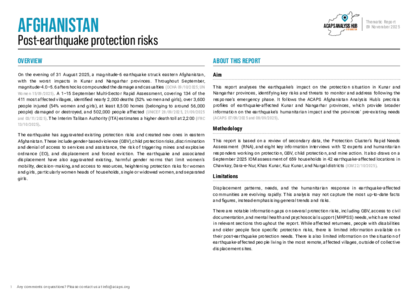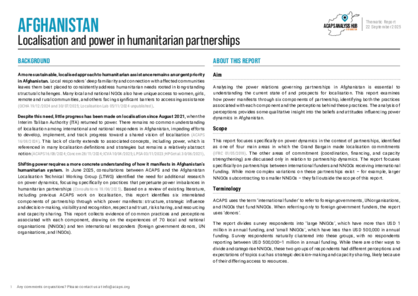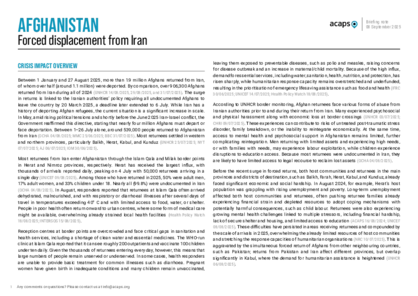Latest updates on country situation
30 September 2025
Since around 16:00 Kabul time on 29 September 2025, Afghanistan has faced a nationwide internet and telecommunications blackout after the Interim Taliban Authority ordered the shutdown of fibre-optic connections. The restriction follows province-level outages since 15 September in Badakhshan, Baghlan, Balkh, Helmand, Herat, Kandahar, Kunduz, Nimroz, Parwan, Takhar, Uruzgan, and Zabul. The impact has been severe particularly on education. Online classes for women and girls have ceased, leaving them without alternatives amid the ban on female education. Livelihoods are also under pressure, with businesses dependent on internet access (especially online women-led enterprises) reporting significant losses. Humanitarians are struggling to coordinate response efforts, submit reports, and maintain contact with remote provinces, where mobile alternatives are unreliable or costly. The blackout has further restricted media and information flows, isolating communities from reliable information. With no clarity on the duration, prolonged restrictions risk intensifying isolation, obstructing humanitarian assistance, and worsening existing needs. (DW 30/09/2025, The Guardian 23/09/2025, TOLOnews 20/09/2025)
09 September 2025
By 4 September 2025, the earthquake in eastern Afghanistan had killed 2,205 people, injured 3,640, and destroyed 6,782 homes across Kunar, Laghman, and Nangarhar provinces, with assessments still underway. Roadblocks from landslides and aftershocks continue to hinder access to many affected areas. Around 499,000 people urgently need assistance, particularly for WASH, protection, food, and education. (IOM 09/09/2025, OCHA 09/09/2025, UNFPA 08/09/2025)
02 September 2025
On 31 August 2025, a magnitude 6.0 earthquake struck eastern Afghanistan, with epicentre near Jalalabad, Nangarhar province. Several aftershocks caused widespread damage across Kunar, Laghman, Nangarhar, and Nuristan provinces. On 2 September, the Interim Taliban Authority reported over 1,400 deaths and 3,100 injuries, with thousands still missing. The death toll is expected to rise as search-and-rescue teams struggle to reach remote mountain communities cut off by landslides and blocked roads. The quake destroyed over 5,400 homes, leaving thousands of families without shelter or belongings. An estimated 6.8 million people live in earthquake-affected provinces, with heavy devastation reported in districts including Alingar (Laghman), Chawkay and Nurgal (Kunar), and Dara-e-Nur (Nangarhar). Hospitals are overwhelmed, and health centres are struggling with damage and a shortage of essential medical supplies, such as IV fluids and bandages. Clean drinking water and sanitation are scarce, raising the risk of disease outbreaks. The disruption to markets and livelihoods has also created an urgent need for food. (OCHA 02/09/2025, IOM 02/09/2025, WHO 02/09/2025)
24 July 2025
In mid-2025, a severe drought continues to affect Afghanistan’s northern, northwestern, and central provinces, crippling rural livelihoods. Livestock losses and acute water shortages are driving income decline. Over 9.5 million people are projected to experience high acute food insecurity – i.e. Crisis (IPC Phase 3) or worse levels – between May–October, with drought as the primary driver. (FAO 06/05/2025, CNN 19/07/2025, OCHA 01/05/2025)
21 July 2025
By 16 July, over 1.5 million Afghans had returned from Iran in 2025, with 60% of them being forcibly deported. This number adds to the over 327,000 Afghans forced to return from Pakistan since the beginning of the year. The increase in returns has heightened critical needs, particularly for WASH, food, and protection. More returns are expected, as Tajikistan has also ordered more than 10,000 Afghan refugees to leave the country within 15 days or face deportation. (UNHCR 17/07/2025, ECHO accessed 21/07/2025, TCA 10/07/2025)
20 May 2025
Since 20 March 2025, more than 242,800 Afghans have returned to Afghanistan from Iran following the Iranian Government’s deadline for extending headcount slips. These mass returns are occurring amid an already deteriorating humanitarian situation in Afghanistan, where returnees face critical challenges upon arrival. In April alone, more than 251,000 Afghans returned from Pakistan and Iran, including more than 96,000 deported. Most lack adequate shelter, income, access to food, clean water, and healthcare. By May 2024, almost 87% of returnee households required housing assistance, 80% needed financial support, and 71% lacked sufficient food. New arrivals are likely to encounter similar hardships. Many families live in informal camps or overcrowded shelters with limited services. The healthcare system faces challenges, and access to education, especially for returnee children and women, is limited. Employment opportunities are scarce, especially for those without documentation, aggravated by the economic crisis. (UNHCR 13/05/2025, UNHCR 29/04/2025, UNHCR 28/05/2024)
21 April 2025
By 15 April, 439 health facilities across Afghanistan had closed or been suspended as a result of US funding cuts, affecting around three million people. Since 4 March, there has been a 163% increase in health facility closures or suspensions. The lack of access to healthcare facilities raises concerns about a potential increase in maternal and infant mortality rates and the aggravation of malnutrition in both urban and rural areas. Between June 2024 and May 2025, approximately 3.5 million children and 1.2 million pregnant and breastfeeding women are projected to face acute malnutrition.
The Taliban’s enforcement of the Mahram rule, which restricts women from leaving the house without a male escort, further limits access to healthcare – particularly when nearby facilities are closed.
Healthcare facility closures compound the ban on women undertaking medical training, potentially creating a long-term shortage of female health workers. In some provinces, women are also prohibited from being treated by male doctors.
(Health Cluster 20/04/2025, Health Cluster 06/03/2025, HRW 03/12/2024)
current crises
in
Afghanistan
These crises have been identified through the INFORM Severity Index, a tool for measuring and comparing the severity of humanitarian crises globally.
AFG007 - Earthquake in eastern provinces 2025
Last updated 28/11/2025
Drivers
Earthquake
Crisis level
Country
Severity level
3.5 High
Access constraints
4.0
AFG001 - Complex crisis
Last updated 28/11/2025
Drivers
Conflict/ Violence
Political/economic crisis
Floods
Drought/drier conditions
Earthquake
Crisis level
Country
Severity level
4.5 Very High
Access constraints
4.0
Active risks
Analysis products
on
Afghanistan
18 December 2025
Afghanistan: localised vulnerability analysis - Injil district and Herat city, Herat province
DOCUMENT / PDF / 534 KB
This analysis reflects on vulnerability drivers in Injil district and Herat city. It intends to support the prioritisation and design of humanitarian and basic human needs assistance in the targeted areas by enhancing humanitarian responders’ understanding of the factors affecting people’s overall vulnerability to basic needs issues, including their capacity to meet their own needs.
12 November 2025
Afghanistan: pre-earthquake needs and implications for the earthquake response in Balkh and Samangan provinces
DOCUMENT / PDF / 393 KB
By highlighting the most pressing pre-earthquake humanitarian needs in Balkh and Samangan provinces and indicating how the earthquake may have aggravated these needs, these profiles provide insight into the potential scope and scale of the earthquake’s impact, supporting response planning and prioritisation.
08 September 2025
Afghanistan: forced displacement from Iran
DOCUMENT / PDF / 351 KB
Between 1 January and 27 August 2025, more than 1.9 million Afghans returned from Iran, of whom over half (around 1.1 million) were deported. By comparison, over 906,300 Afghans returned from Iran during all of 2024.







